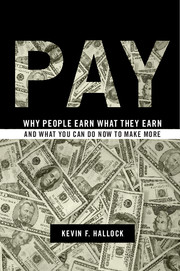Book contents
- Frontmatter
- Contents
- Figures
- Tables
- Acknowledgments
- PART I HOW HARD CAN THIS BE?
- 1 Common Sense, Economics, and HR
- 2 Wages, the Wage Distribution, and Wage Inequality
- 3 The Facts
- 4 The Difference Between Wages and Total Compensation
- PART II HOW ORGANIZATIONS SET PAY STRUCTURE AND WHY
- PART III HOW PEOPLE ARE PAID CAN MEAN AS MUCH AS HOW MUCH THEY ARE PAID
- PART IV WHAT YOU CAN DO TO MAKE MORE AND CONCLUDING COMMENTS
- Notes
- References
- Index
2 - Wages, the Wage Distribution, and Wage Inequality
from PART I - HOW HARD CAN THIS BE?
Published online by Cambridge University Press: 05 October 2012
- Frontmatter
- Contents
- Figures
- Tables
- Acknowledgments
- PART I HOW HARD CAN THIS BE?
- 1 Common Sense, Economics, and HR
- 2 Wages, the Wage Distribution, and Wage Inequality
- 3 The Facts
- 4 The Difference Between Wages and Total Compensation
- PART II HOW ORGANIZATIONS SET PAY STRUCTURE AND WHY
- PART III HOW PEOPLE ARE PAID CAN MEAN AS MUCH AS HOW MUCH THEY ARE PAID
- PART IV WHAT YOU CAN DO TO MAKE MORE AND CONCLUDING COMMENTS
- Notes
- References
- Index
Summary
This chapter focuses on four main areas. First, how much are people paid in the United States today – how are wages distributed? If you earn $25 per hour, is that relatively highly paid or not? Second, we will consider the issue of wage inequality. Given the obvious news about CEO pay levels, clearly some people are paid extremely high wages, but how many? Do a large fraction of people earn less than $10 per hour? Do a large fraction earn more than $50 per hour? After we establish the “spread” in wages across different kinds of workers, we will turn to the question of whether wage patterns and wage inequality have changed over time. Using data from the U.S. Census Bureau over a thirty-year period, I document that the “spread” in wages in the United States has, in fact, changed quite dramatically in the last generation. Next, I document the difference between CEO pay and that of “other” workers. As has been documented, the difference between CEO pay and most other workers’ pay has increased greatly in the last generation. In this chapter, we explore what this means and foreshadow a deeper discussion of executive compensation, which we pick up again in Chapter 8. Finally, I discuss the intergenerational correlation and transmission of wages. That is, if you have a wage that is particularly high or low, how likely are your children to have the same kind of wage?
What do Wages Look Like in the United States?
The “median” wage in the United States was $16.83 per hour in 2010. This means that just as many people earned more than $16.83 per hour that year as earned less than that. It was the “middle” wage. Is this number big or small? Your answer to that question may depend on whether you or your friends or family or people you know make more or less than that amount (more on this later). A few years ago, I took a group of (roughly eighteen-year-old) Cornell University freshman undergraduate students to a local manufacturing facility as part of a class project. When we were talking with the head of HR for the plant, one of the students asked what the “starting hourly wage” was for the plant. We were told that it was about $13.50 per hour. It was interesting to see that some students thought that $13.50 was so much money and others thought it was so little money. On average, those students who came from families that had lower wages thought that was a lot and those students who came from higher-earning families thought it was little.
- Type
- Chapter
- Information
- PayWhy People Earn What They Earn and What You Can Do Now to Make More, pp. 10 - 20Publisher: Cambridge University PressPrint publication year: 2012



